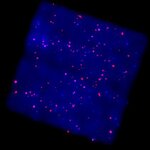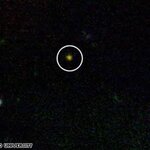Space

What happened in the first trillionth of a trillionth of a trillionth of a second after the Big Bang? Super-sensitive microwave detectors, built at the National Institute of Standards and Technology (NIST), may soon help scientists find out.
The new sensors, described today at the American Physical Society (APS) meeting in Denver, were made for a potentially ground-breaking experiment by a collaboration involving NIST, Princeton University, the University of Colorado at Boulder, and the University of Chicago.
NIST is best known for earthbound measurements but a current project at NIST’s…

So you wanna be an astrophysicist? Try this route!
Leave a well-paying NASA job to get a Ph.D.
Begin studying solar CMEs ... while the sun is at solar minimum.
Assessing how the web is kicking print media's butt, consider shifting career to ... journalism?
I suppose some explanation is necessary. I admit having to stop doing research so I could get a Ph.D. to do research sounds silly, but my Ph.D. really did kick up my access to do science. In many ways, a Ph.D. is like a union card. And starting coronal mass ejection (CME) work during the sun's boring cycle was 'mission-driven'-- because…
For over three decades, globes of Mercury were blank on one side. Though Mariner 10 explored the small planet in three flybys in 1974 and 1975, no more than half was ever seen. Of the four terrestrial planets – Mercury, Venus, Earth and Mars - we knew the least about Mercury.
On Oct. 6, 2008, the MErcury Surface, Space ENvironment, GEochemistry, and Ranging spacecraft, better known as MESSENGER, made its second close-approach flyby of Mercury. 30 years after man's first look, MESSENGER has revealed Mercury in its entirety - well, mostly. Using high-resolution and multispectral images…

An extremely deep Chandra X-ray Observatory image of a region near the center of our Galaxy has resolved a long-standing mystery about an X-ray glow along the plane of the Galaxy. The glow in the region covered by the Chandra image was discovered to be caused by hundreds of point-like X- ray sources, implying that the glow along the plane of the Galaxy is due to millions of such sources.
This image shows an infrared view from the Spitzer Space Telescope of the central region of the Milky Way, with a pullout showing a Chandra image of a region located only 1.4 degrees away from the center of…

From CNN:
Scientists spot oldest ever object in universe
Wow, that gamma ray from the exploding star GRB 090423 is so old. Why do we even keep it around? It’s like, 95% as old as time. And what an eyesore. We can see it from anywhere in the universe.

Calculations by Ryan O'Leary and Avi Loeb of the Harvard-Smithsonian Center for Astrophysics suggest that hundreds of massive black holes, left over from the galaxy-building days of the early universe, may wander the Milky Way. Rogue black holes roaming our galaxy, threatening to swallow anything that gets too close? Do we call the UN?
No, Earth is safe. The closest rogue black hole should reside thousands of light-years away. Astronomers are eager to locate them, though, for the clues they will provide to the formation of the Milky Way.
"These black holes are relics…
The Daytime Astronomer, Tues&Fri here, via RSS feed, and twitter @skydayTwo days ago, I woke up blind. Couldn't open my eyes-- lids were fused shut. For that early morning hour, I had to question just what I would do as a blind astronomer.
I'd had blurry vision the night before, but this was still unexpected. Pragmatically, I found my way to a sink to try and flush out my eyes, get some vision back. To avoid false suspense-- I was able to see (mostly) in fairly short order. And I can safely assure you there is a huge emotional difference between 'no sight' and 'can see slightly'.
I…

In ancient stories, and even some newer ones, the appearance of a comet or any heavenly object could symbolize a God's displeasure and even mean a sure failure in battle for one side. Tel Aviv University researchers say comets could be even more relevant than mythology suggests; they might have actually provided the elements for the emergence of life on our planet.
While investigating the chemical make-up of comets, Prof. Akiva Bar-Nun of the Department of Geophysics and Planetary Sciences at Tel Aviv University found they were the source of missing ingredients needed for life in Earth…

The farthest we have 'seen' in space just got a little farther away, thanks to ESO's Very Large Telescope and GRB (Gamma Ray Burst) 090423.
VLT has shown that a faint gamma-ray burst detected last Thursday is the signature of the explosion of the earliest, most distant known object in the Universe (a redshift of 8.2). The explosion apparently took place more than 13 billion years ago, only about 600 million years after the Big Bang.
The previous record holder for the most distant GRB — first detected by Swift last year and then also studied with the VLT — had a redshift of 6.7. The blast,…

1609 Johann Kepler formalizes his first and second laws of planetary motion